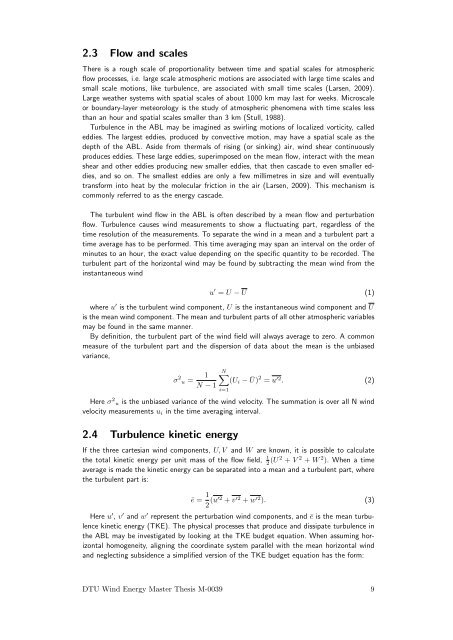Boundary-layer height detection with a ceilometer at a coastal ... - Orbit
Boundary-layer height detection with a ceilometer at a coastal ... - Orbit
Boundary-layer height detection with a ceilometer at a coastal ... - Orbit
Create successful ePaper yourself
Turn your PDF publications into a flip-book with our unique Google optimized e-Paper software.
2.3 Flow and scales<br />
There is a rough scale of proportionality between time and sp<strong>at</strong>ial scales for <strong>at</strong>mospheric<br />
flow processes, i.e. large scale <strong>at</strong>mospheric motions are associ<strong>at</strong>ed <strong>with</strong> large time scales and<br />
small scale motions, like turbulence, are associ<strong>at</strong>ed <strong>with</strong> small time scales (Larsen, 2009).<br />
Large we<strong>at</strong>her systems <strong>with</strong> sp<strong>at</strong>ial scales of about 1000 km may last for weeks. Microscale<br />
or boundary-<strong>layer</strong> meteorology is the study of <strong>at</strong>mospheric phenomena <strong>with</strong> time scales less<br />
than an hour and sp<strong>at</strong>ial scales smaller than 3 km (Stull, 1988).<br />
Turbulence in the ABL may be imagined as swirling motions of localized vorticity, called<br />
eddies. The largest eddies, produced by convective motion, may have a sp<strong>at</strong>ial scale as the<br />
depth of the ABL. Aside from thermals of rising (or sinking) air, wind shear continuously<br />
produces eddies. These large eddies, superimposed on the mean flow, interact <strong>with</strong> the mean<br />
shear and other eddies producing new smaller eddies, th<strong>at</strong> then cascade to even smaller eddies,<br />
and so on. The smallest eddies are only a few millimetres in size and will eventually<br />
transform into he<strong>at</strong> by the molecular friction in the air (Larsen, 2009). This mechanism is<br />
commonly referred to as the energy cascade.<br />
The turbulent wind flow in the ABL is often described by a mean flow and perturb<strong>at</strong>ion<br />
flow. Turbulence causes wind measurements to show a fluctu<strong>at</strong>ing part, regardless of the<br />
time resolution of the measurements. To separ<strong>at</strong>e the wind in a mean and a turbulent part a<br />
time average has to be performed. This time averaging may span an interval on the order of<br />
minutes to an hour, the exact value depending on the specific quantity to be recorded. The<br />
turbulent part of the horizontal wind may be found by subtracting the mean wind from the<br />
instantaneous wind<br />
u ′ = U − U (1)<br />
where u ′ is the turbulent wind component, U is the instantaneous wind component and U<br />
is the mean wind component. The mean and turbulent parts of all other <strong>at</strong>mospheric variables<br />
may be found in the same manner.<br />
By definition, the turbulent part of the wind field will always average to zero. A common<br />
measure of the turbulent part and the dispersion of d<strong>at</strong>a about the mean is the unbiased<br />
variance,<br />
σ 2 u = 1<br />
N − 1<br />
N∑<br />
(U i − Ū)2 = u ′2 . (2)<br />
i=1<br />
Here σ 2 u is the unbiased variance of the wind velocity. The summ<strong>at</strong>ion is over all N wind<br />
velocity measurements u i in the time averaging interval.<br />
2.4 Turbulence kinetic energy<br />
If the three cartesian wind components, U, V and W are known, it is possible to calcul<strong>at</strong>e<br />
the total kinetic energy per unit mass of the flow field, 1 2 (U 2 + V 2 + W 2 ). When a time<br />
average is made the kinetic energy can be separ<strong>at</strong>ed into a mean and a turbulent part, where<br />
the turbulent part is:<br />
ē = 1 2 (u′2 + v ′2 + w ′2 ). (3)<br />
Here u ′ , v ′ and w ′ represent the perturb<strong>at</strong>ion wind components, and ē is the mean turbulence<br />
kinetic energy (TKE). The physical processes th<strong>at</strong> produce and dissip<strong>at</strong>e turbulence in<br />
the ABL may be investig<strong>at</strong>ed by looking <strong>at</strong> the TKE budget equ<strong>at</strong>ion. When assuming horizontal<br />
homogeneity, aligning the coordin<strong>at</strong>e system parallel <strong>with</strong> the mean horizontal wind<br />
and neglecting subsidence a simplified version of the TKE budget equ<strong>at</strong>ion has the form:<br />
DTU Wind Energy Master Thesis M-0039 9
















